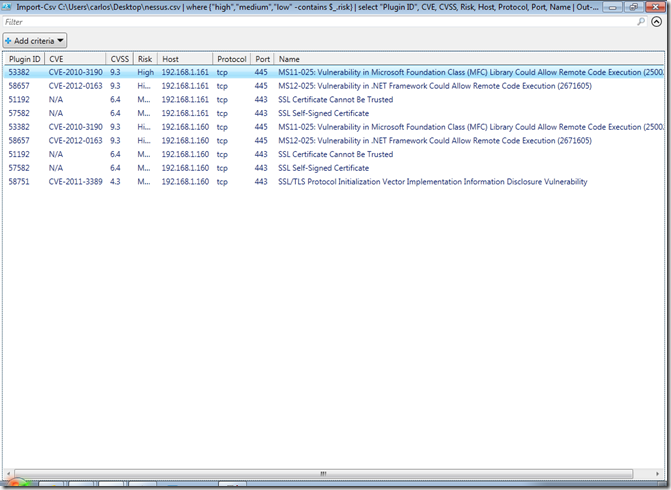Parsing Nessus CSV Reports with PowerShell
Recently in the Pauldotcom Podcast Paul was mentioning how he uses Awk, cut and other bash tools to process a Nessus CSV report file and format the host output so he could use it in another tool. I saw his command and thought I would do it in PowerShell for kicks since PowerShell turns each row in to an object I can manipulate. Lets take a look at the Import-Csv cmandlet and what are the members of the object it returns:
Import-Csv C:\Users\carlos\Desktop\nessus.csv | Get-MemberTypeName: System.Management.Automation.PSCustomObjectName MemberType Definition---- ---------- ----------Equals Method bool Equals(System.Object obj)GetHashCode Method int GetHashCode()GetType Method type GetType()ToString Method string ToString()CVE NoteProperty System.String CVE=N/ACVSS NoteProperty System.String CVSS=Description NoteProperty System.String Description=One of several ports that were previously o...Host NoteProperty System.String Host=192.168.1.161Name NoteProperty System.String Name=Open Port Re-checkPlugin ID NoteProperty System.String Plugin ID=10919Plugin Output NoteProperty System.String Plugin Output=Port 49156 was detected as being open but...Port NoteProperty System.String Port=0Protocol NoteProperty System.String Protocol=tcpRisk NoteProperty System.String Risk=NoneSolution NoteProperty System.String Solution=- increase checks_read_timeout and/or reduce m...Synopsis NoteProperty System.String Synopsis=Previously open ports are now closed.
We can see that the Nessus data for each plugin that ran is represented as NoteProperty for the object as a string. Lets see if I have some vulnerabilities found that it reports as being High for this we will use the Where-Object cmdlet to filter the objects:
Great we found several. One advantage is that PowerShell is not case sensitive in it's operators unless you implicitly specify it, this allows me to specify the risk and “hight” and the value being capitalized . Now lets say I want to know what hosts have high vulnerabilities and only want their IP returned, for this we will use the Select-Object cmdlet and only get unique entries:Import-Csv C:\Users\carlos\Desktop\nessus.csv | where {$_.risk -eq "high"}Plugin ID : 53382CVE : CVE-2010-3190CVSS : 9.3Risk : HighHost : 192.168.1.161Protocol : tcpPort : 445Name : MS11-025: Vulnerability in Microsoft Foundation Class (MFC) Library Could AllowRemote Code Execution (2500212)Synopsis : Arbitrary code can be executed on the remote host through the Microsoft FoundationClass library.Description : The remote Windows host contains a version of the Microsoft Foundation Class (MFC)library affected by an insecure library loading vulnerability. The path used forloading external libraries is not securely restricted.An attacker can exploit this by tricking a user into opening an MFC application ina directory that contains a malicious DLL, resulting in arbitrary code execution.Solution : Microsoft has released a set of patches for Visual Studio .NET 2003, 2005, and2008, as well as Visual C++ 2005, 2008, and 2010 :http://technet.microsoft.com/en-us/security/bulletin/ms11-025Plugin Output :The following Visual C++ Redistributable Package has notbeen patched :Product : Visual C++ 2008 SP1 Redistributable PackageInstalled version : 9.0.30729.4148Fixed version : 9.0.30729.6161.......
Import-Csv C:\Users\carlos\Desktop\nessus.csv | where {$_.risk -eq "high"} | select host -UniqueHost----192.168.1.161192.168.1.160
We could also filter by plugin if we are performing a pentest and what to come up with list of targets to feed to a tool piping it to the cmdlet out-file and giving it a file to save the IP’s to.
If we like doing all of the matching and sorting in a GUI interface we can take a look of the results in a grid view. Lets look at high, medium and low vulnerabilities and we will look at the Plugin ID, CVE, CVSS, Risk, Host, Protocol, Port and Name:
Import-Csv C:\Users\carlos\Desktop\nessus.csv | where {"high","medium","low" -contains $_.risk} | select "Plugin ID", CVE, CVSS, Risk, Host, Protocol, Port, Name | Out-GridView
This would bring up the following screen for us to filter and sort the information in a graphical manner:
Now what if we want to turn the data in to an HTML Report, well PowerShell also allows us to do it using the ConvertTo-Html cmdlet and turn it in to an HTML report in list format:
Import-Csv C:\Users\carlos\Desktop\nessus.csv | where {"high","medium","low" -contains $_.risk} | select "Plugin ID", CVE, CVSS, Risk, Host, Protocol, Port, Name | ConvertTo-Html -As List > report.html
This will create a report that looks like this:
One could go even fancier with pre-made CSS and HTML templates, but I will leave that for you to explore.

